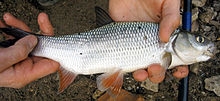The Daceposted on 8 February 2015 | posted in Hints and Tipsommon name: Dace Latin name: Leuciscus leuciscus Record weight: 1lb 4oz 4 dram. Caught by J. L. Gasson from the Little Ouse River in Norfolk in 1960. Distribution: Once very common in the UK, dace, and particularly large dace, are becoming increasingly rare. Possible reasons for the decline in dace populations are low flows leading to poor spawning and increased predation from cormorants. Found throughout Northern Europe, although it tends to be found in cooler countries. Not found in Iberia. Absent from the South West of England and Ireland. Found in the South of Scotland only. Features: A slim silver-flanked fish with grey fins. Often mistaken for chub (although the dace has a smaller mouth and concave shaped anal fin) and roach (which have red fins and are plumper). Diet: Dace are specialist drift feeders. In rich rivers dace will spend the days resting up in open shallow water away from predators. As dusk approaches the fish will move upstream to a shallow gravel riffle where, as the light begins to fail, large numbers of caddis fly larvae begin to drift downstream. The dace feed hard on these invertebrates through the night, although feeding is most intense at dawn and dusk. In poorer environments dace will have a broader diet feeding on a wide range of small invertebrates that are either picked from the drift or from the river bed.  Spawning: Dace are the earliest spawning of all coarse fish. Even when the mornings are still frosty in early March, dace will be found massing in the deeper water before shallow gravel riffles. The fish often travel several miles to reach the right conditions for spawning and in the days leading up to spawning several thousand fish may have gathered. At this time the male fish develop very fine spawning tubercles and have a very rough feel to their skin. The females are smoother and much plumper. All of the dace spawn over a period of about a week on the clean gravel shallows. Because of the cold water conditions the eggs take about three weeks to hatch. Growth: Dace are one of the shorter lived coarse fish. In rich rivers the dace grow very quickly, reaching sexual maturity in three years, and only live to be seven or eight. In poorer environments the dace grow more slowly, but live for up to twelve years. Thanks to their love of cool water dace are able to grow even at temperatures of eight centigrade. This enables them to do particularly well in the cool waters of Scandinavia. |








.jpg)
.jpg)





